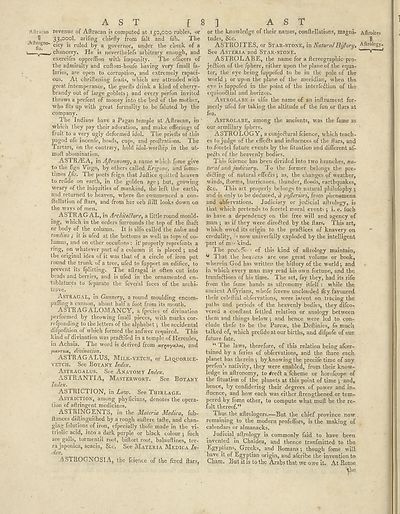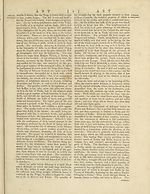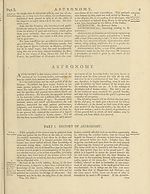Encyclopaedia Britannica, or, a Dictionary of arts, sciences, and miscellaneous literature : enlarged and improved. Illustrated with nearly six hundred engravings > Volume 3, ASS-BOO
(16) Page 8
Download files
Complete book:
Individual page:
Thumbnail gallery: Grid view | List view

AST [ 8 ] AST
Aftracan revenue of Aftracan is computed at 150,000 rubles, or
II 33,0001. arifing chiefly from fait and flfli. The
^no",city is ruled by a governor, under the check of a
1 ■ chancery. He is neverthelefs arbitrary enough, and
exercifes oppreflion with impunity. The officers of
the admiralty and cuftom-houfe having very fmall fa-
laries, are open to corruption, and extremely rapaci¬
ous. At chriftening feaits, which are attended with
great intemperance, the guefts drink a kind of cherry-
brandy out of large goblets; and every perfon invited
throws a prefent of money into the bed of the mother,
"who fits up with great formality to be faluted by the
company.
The Indians have a Pagan temple at Aftracan, in
which they pay their adoration, and make offerings of
fruit to a very ugly deformed idol. The priefts of this
pagod ufe incenfe, beads, cups, and proftrations. The
Tartars, on the contrary, hold idol-worftiip in the ut-
moft: abomination.
ASTRiEA, in AJlronomy, a name which fume give
to the fign Virgo, by others called Erigone, and fome-
times IJis. The poets feign that Juftice quitted heaven
to refide on earth, in the golden age j but, growing
weary of the iniquities of mankind, ike left the earth,
and returned to heaven, where (lie commenced a con-
ftellation of ftars, and from her orb ftill looks down on
the ways of men.
ASTRAGAL, in ArchiteBure, a little round mould-
ing, which in the orders furrounds the top of the ftiaft
or body of the column. It is alfo called the talon and
tondino ; it. is ufed at the bottoms as well as tops of co¬
lumns, and on other occafions : it’properly reprefents a
ring, on whatever part of a column it is placed 5 and
the original idea of it was that of a circle of iron put
round the trunk of a tree, ufed to fupport an edifice, to
prevent its fplitting. The aftragal is often cut into
beads and berries, and is ufed in the ornamented en¬
tablatures to feparate the feveral faces of the archi¬
trave.
Astragal, in Gunnery, a round moulding encom-
paffing a cannon, about half a foot from its mouth.
AS 1 RAGALOMANCY, a fpecies of divination
performed by throwing fmall pieces, with marks cor-
refponding to the letters of the alphabet ; the accidental
difpofition of which formed the anfwer required. This
kind of divination was pradlifed in a temple of Hercules,
in Achaia. The word is derived from ajrjayaAes, and
divination.
ASTRAGALUS, Milk-vetch, or Liquorice-
vetch. See Botany Index.
Astragalus. See Anatomy Index.
ASTRANTIA, Masterwort. See Botany
Index*
AS FRICTION, \n Law. See Thirlage.
Astriction, among phyficians, denotes the opera¬
tion of aftringent medicines.
AS IRINGEN1 S, in the Materia Me die a, fub-
ftances diftinguiftied by a rough auftere tafte, and chan¬
ging folutions of iron, efpecially thofe made in the vi¬
triolic acid, into a dark purple or black colour *, fuch
are galls, torment'd root, biftort root, balauftines, ter¬
ra japonica, acacia, &c. See Materia Medica In¬
dex.
ASTROGNOSIA, the fcience of the fixed ftars,
or the knowledge of their names, conftellalions, magni- Aftroites
tudes, &c. H
ASTROITES, or Star-stone, in Natural Hi/lory* A^rolog>'*
See Asteria and Star-STONE. >—-y——f
ASTROLABE, the name for a ftereographic pro-
jedtion of the fphere, either upon the plane of the equa¬
tor, the eye being fuppofed to be in the pole of the
wmrld ; or upon the plane of the meridian, when the
eye is fuppofed in the point of the interfcdlion of the
equinodtial and horizon.
Astrolabe is alfo the name of an inftrument for¬
merly ufed for taking the altitude of the fun or ftars at
fea.
Astrolabe, among the ancients, w as the fame as
our armillary fphere.
ASTROLOGY, a conjedtural fcience, which teach¬
es to judge of the effedfs and influences of the ftars, and
to foretel future events by the fituation and different af-
pedfs of the heavenly bodies.
This fcience has been divided into two branches, na¬
tural and judiciary. To the former belongs the pre-
didfing of natural effedts} as, the changes of weather,
winds, ftorms, hurricanes, thunder, floods, earthquakes,
&c. This art properly belongs to natural philofophy 5
and is only to be deduced, d pojleriori, from phenomena
and obfervations. Judiciary or judicial aftrology, is
that which pretends to foretel moral events 5 i. e. fuch
as have a dependency on the free will and agency of
man ; as if they were dlredted by the flars. This art,
which owed its origin to the pradlices of knavery on
credulity. N now univerfally exploded by the intelligent
part of m u kind.
The proteffo- - of this kind of aftrology maintain,
^ That the heavens are one great volume or book,
wherein God has written the hiftory of the world j and
in which every man may read his own fortune, and the
tranfadlions of his time. The art, fay they, had its rife
from the fame hands as aftronomy itfelf : while the
ancient Affyrians, whofe ferene unclouded Iky. favoured
their celeftial obfervations, were intent on tracing the
paths and periods of the heavenly bodies, they difeo-
vered a conftant fettled relation or analogy between
them and things below 5 and hence were led to con¬
clude tbefe to be the Parcae, the Heftinies, fo much
talked of, wdiich prefideatour births, and difpofe of our
future fate.
“ I he laws, therefore, of this relation being afeer-
tained by a feides of obfervations, and the ftrare each
planet has therein •, by knowing the precife time of any
perfon’s nativity, they were enabled, from their know¬
ledge in aftronomy, to rfreff a fcheme or horofeope of
the fituation of the planets at this point of time j and,
hence, by confidering their degrees of power and in¬
fluence, and how each was either (Lengthened or tem¬
pered by fome other, to compute what muft be the re-
fult thereof.”
1 hus the aftrologers.—But the chief province now
remaining to the modern profeffors, is the making of
calendars or almanacks.
Judicial aftrology is commonly faid to have been
invented in Chaldea, and thence tranfmitted to the
Greeks, and Romans though fome will
have it of Egyptian origin, and aferibe the invention to
Cham. But it is to the Arabs that we owe it. At Rome
the
Aftracan revenue of Aftracan is computed at 150,000 rubles, or
II 33,0001. arifing chiefly from fait and flfli. The
^no",city is ruled by a governor, under the check of a
1 ■ chancery. He is neverthelefs arbitrary enough, and
exercifes oppreflion with impunity. The officers of
the admiralty and cuftom-houfe having very fmall fa-
laries, are open to corruption, and extremely rapaci¬
ous. At chriftening feaits, which are attended with
great intemperance, the guefts drink a kind of cherry-
brandy out of large goblets; and every perfon invited
throws a prefent of money into the bed of the mother,
"who fits up with great formality to be faluted by the
company.
The Indians have a Pagan temple at Aftracan, in
which they pay their adoration, and make offerings of
fruit to a very ugly deformed idol. The priefts of this
pagod ufe incenfe, beads, cups, and proftrations. The
Tartars, on the contrary, hold idol-worftiip in the ut-
moft: abomination.
ASTRiEA, in AJlronomy, a name which fume give
to the fign Virgo, by others called Erigone, and fome-
times IJis. The poets feign that Juftice quitted heaven
to refide on earth, in the golden age j but, growing
weary of the iniquities of mankind, ike left the earth,
and returned to heaven, where (lie commenced a con-
ftellation of ftars, and from her orb ftill looks down on
the ways of men.
ASTRAGAL, in ArchiteBure, a little round mould-
ing, which in the orders furrounds the top of the ftiaft
or body of the column. It is alfo called the talon and
tondino ; it. is ufed at the bottoms as well as tops of co¬
lumns, and on other occafions : it’properly reprefents a
ring, on whatever part of a column it is placed 5 and
the original idea of it was that of a circle of iron put
round the trunk of a tree, ufed to fupport an edifice, to
prevent its fplitting. The aftragal is often cut into
beads and berries, and is ufed in the ornamented en¬
tablatures to feparate the feveral faces of the archi¬
trave.
Astragal, in Gunnery, a round moulding encom-
paffing a cannon, about half a foot from its mouth.
AS 1 RAGALOMANCY, a fpecies of divination
performed by throwing fmall pieces, with marks cor-
refponding to the letters of the alphabet ; the accidental
difpofition of which formed the anfwer required. This
kind of divination was pradlifed in a temple of Hercules,
in Achaia. The word is derived from ajrjayaAes, and
divination.
ASTRAGALUS, Milk-vetch, or Liquorice-
vetch. See Botany Index.
Astragalus. See Anatomy Index.
ASTRANTIA, Masterwort. See Botany
Index*
AS FRICTION, \n Law. See Thirlage.
Astriction, among phyficians, denotes the opera¬
tion of aftringent medicines.
AS IRINGEN1 S, in the Materia Me die a, fub-
ftances diftinguiftied by a rough auftere tafte, and chan¬
ging folutions of iron, efpecially thofe made in the vi¬
triolic acid, into a dark purple or black colour *, fuch
are galls, torment'd root, biftort root, balauftines, ter¬
ra japonica, acacia, &c. See Materia Medica In¬
dex.
ASTROGNOSIA, the fcience of the fixed ftars,
or the knowledge of their names, conftellalions, magni- Aftroites
tudes, &c. H
ASTROITES, or Star-stone, in Natural Hi/lory* A^rolog>'*
See Asteria and Star-STONE. >—-y——f
ASTROLABE, the name for a ftereographic pro-
jedtion of the fphere, either upon the plane of the equa¬
tor, the eye being fuppofed to be in the pole of the
wmrld ; or upon the plane of the meridian, when the
eye is fuppofed in the point of the interfcdlion of the
equinodtial and horizon.
Astrolabe is alfo the name of an inftrument for¬
merly ufed for taking the altitude of the fun or ftars at
fea.
Astrolabe, among the ancients, w as the fame as
our armillary fphere.
ASTROLOGY, a conjedtural fcience, which teach¬
es to judge of the effedfs and influences of the ftars, and
to foretel future events by the fituation and different af-
pedfs of the heavenly bodies.
This fcience has been divided into two branches, na¬
tural and judiciary. To the former belongs the pre-
didfing of natural effedts} as, the changes of weather,
winds, ftorms, hurricanes, thunder, floods, earthquakes,
&c. This art properly belongs to natural philofophy 5
and is only to be deduced, d pojleriori, from phenomena
and obfervations. Judiciary or judicial aftrology, is
that which pretends to foretel moral events 5 i. e. fuch
as have a dependency on the free will and agency of
man ; as if they were dlredted by the flars. This art,
which owed its origin to the pradlices of knavery on
credulity. N now univerfally exploded by the intelligent
part of m u kind.
The proteffo- - of this kind of aftrology maintain,
^ That the heavens are one great volume or book,
wherein God has written the hiftory of the world j and
in which every man may read his own fortune, and the
tranfadlions of his time. The art, fay they, had its rife
from the fame hands as aftronomy itfelf : while the
ancient Affyrians, whofe ferene unclouded Iky. favoured
their celeftial obfervations, were intent on tracing the
paths and periods of the heavenly bodies, they difeo-
vered a conftant fettled relation or analogy between
them and things below 5 and hence were led to con¬
clude tbefe to be the Parcae, the Heftinies, fo much
talked of, wdiich prefideatour births, and difpofe of our
future fate.
“ I he laws, therefore, of this relation being afeer-
tained by a feides of obfervations, and the ftrare each
planet has therein •, by knowing the precife time of any
perfon’s nativity, they were enabled, from their know¬
ledge in aftronomy, to rfreff a fcheme or horofeope of
the fituation of the planets at this point of time j and,
hence, by confidering their degrees of power and in¬
fluence, and how each was either (Lengthened or tem¬
pered by fome other, to compute what muft be the re-
fult thereof.”
1 hus the aftrologers.—But the chief province now
remaining to the modern profeffors, is the making of
calendars or almanacks.
Judicial aftrology is commonly faid to have been
invented in Chaldea, and thence tranfmitted to the
Greeks, and Romans though fome will
have it of Egyptian origin, and aferibe the invention to
Cham. But it is to the Arabs that we owe it. At Rome
the
Set display mode to:
![]() Universal Viewer |
Universal Viewer | ![]() Mirador |
Large image | Transcription
Mirador |
Large image | Transcription
Images and transcriptions on this page, including medium image downloads, may be used under the Creative Commons Attribution 4.0 International Licence unless otherwise stated. ![]()
| Permanent URL | https://digital.nls.uk/193166669 |
|---|
| Attribution and copyright: |
|
|---|
| Description | Ten editions of 'Encyclopaedia Britannica', issued from 1768-1903, in 231 volumes. Originally issued in 100 weekly parts (3 volumes) between 1768 and 1771 by publishers: Colin Macfarquhar and Andrew Bell (Edinburgh); editor: William Smellie: engraver: Andrew Bell. Expanded editions in the 19th century featured more volumes and contributions from leading experts in their fields. Managed and published in Edinburgh up to the 9th edition (25 volumes, from 1875-1889); the 10th edition (1902-1903) re-issued the 9th edition, with 11 supplementary volumes. |
|---|---|
| Additional NLS resources: |
|

